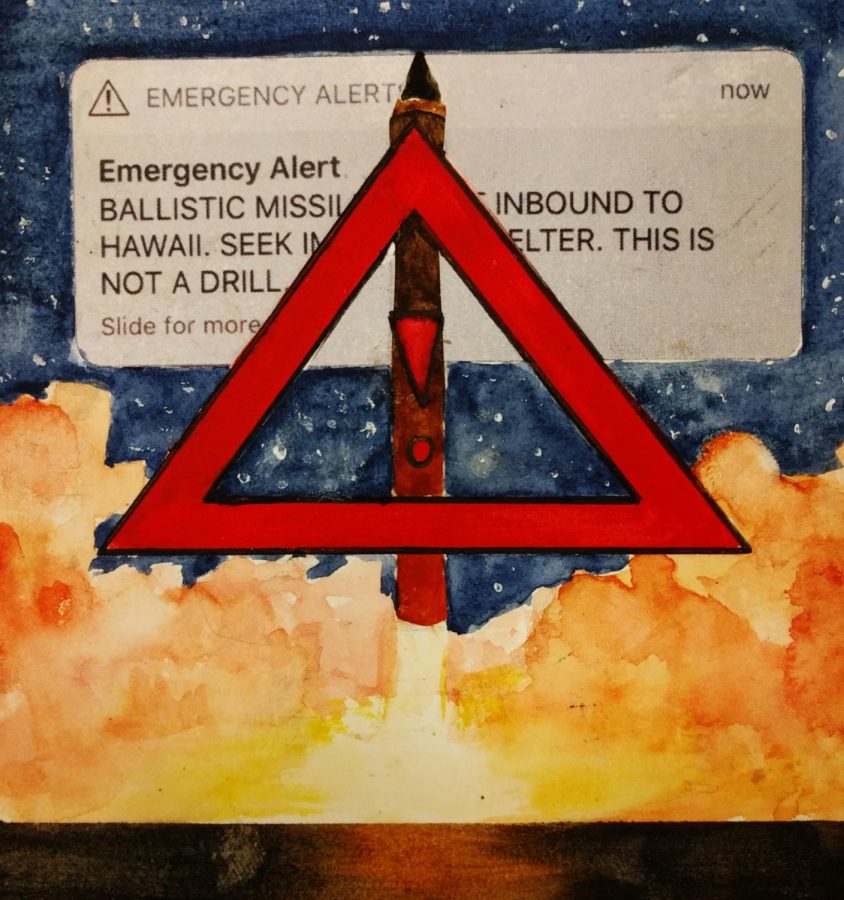“Not a Drill:” Hawaii’s Ballistic Missile Scare
February 27, 2018
“BALLISTIC MISSILE THREAT INBOUND TO HAWAII. SEEK IMMEDIATE SHELTER. THIS IS NOT A DRILL.” On Saturday, January 13, Hawaiian residents received those words in the form of cell phone notifications sent out by Hawaii’s Wireless Emergency Alert System, prompting panic among the citizens of the state.
However, thirty-eight minutes later, another alert was sent out–this time to inform residents of the islands that the first was, in fact, a false one.
Eventually, officials came forward with an explanation as to why the false alert was sent out. Vern Miyagi, the head of Hawaii’s state emergency management agency, explained that it was due to user error, with a government employee having selected the wrong option from a drop-down menu that was part of a computer program, which resulted in a real missile threat alert being sent out, rather than the intended drill.
More recently, on January 22, Hawaii’s governor, David Ige, came forward with information that shed light on part of the reason why the second alert took so long to arrive, explaining to reporters that part of the reason was that he had forgotten his Twitter password, rendering him unable to tweet out the news to Hawaiians that had received the first alert and opening himself and Hawaii’s emergency management agency up for criticism for the slow response to the false alert and the false alert itself.
However, due to the faulty first alert, people are taking the chance to shed light on the shortcomings of emergency management technology, such as the system used in Hawaii. Images circulating of a missile alert interface similar to what would have been put into use in Hawaii have led to widespread criticism of the seemingly outdated warning systems in use, specifically the confusing appearance of the drop-down menu used to determine which kind of alert is sent out.
Vikram Agrawal ‘20 explains that “The false alarm itself demonstrates how behind our military software technology has become. How is it that Microsoft Word asks me to confirm before closing an unsaved document, but the nuclear siren of the most militarily advanced nation in the world, doesn’t? We as a country need to spend smarter, instead of spending larger.” He echoes calls across the nation for proactive development of better warning systems to replace the one used in Hawaii and likely many other states.
In addition to matters regarding the warning system itself, the false missile alert and the widespread, panicked reaction emphasizes the tenuous state of relations between American and North Korean relations such that a missile alert is a grim reality, a new fear added to the lives of citizens of Hawaii and other states within range of North Korea’s missiles.
Fiona He ‘19 commentates, “Because the Hawaiians so fully believed that the event was real, one can easily see the high tensions that many Americans feel due to the strange and frightening relationship between the United States and North Korea,” highlighting the all-too-real possibility that North Korea might launch a missile at any time. She adds that she “truly can’t imagine the panicked fear and terror that these citizens experienced from the warning. I am curious to see what change this error will create in the defense procedures of some of our military bases, and how we can combat such a stressful occurrence from repeating in the future,” showing the watchful eye the nation has cast on its own warning systems.
Now, weeks after that first alert was issued, after information and criticism have come to light, America finds itself faced with a slew of newfound problems to deal with: the renewal of potentially outdated warning systems, the need to revamp military and information technology in general, and now the very grim reality that a North Korean missile headed towards the mainland is not a very far-fetched situation–but only time will tell if these problems can be solved effectively.

